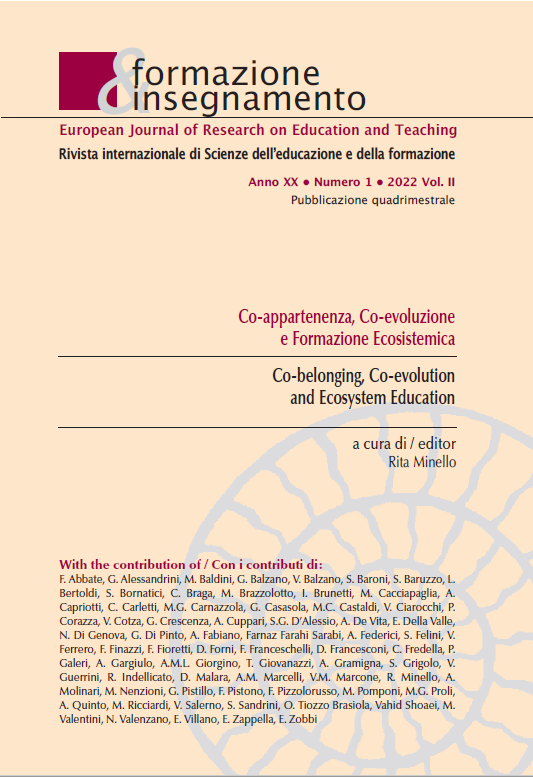The Inclusion of Students with Learning Disabilities at University: An Explorative Inquiry at Flinders University
DOI:
https://doi.org/10.7346/-fei-XX-01-22_62Keywords:
Inclusion, Learning disabilities, University, Instructional technologyAbstract
This paper aims to address a current issue for Special Pedagogy: the educational inclusion of students with learning disabilities in academic settings. Specifically, what is presented in these pages represents part of a broader investigation activity carried out by the writer during the three-year Ph.D. program. In 2019, it has been possible to extend the data collection within Flinders University in Adelaide (South Australia) thanks to the support of «Erasmus+ study 2018/19» funds. The Australian experience represents, in fact, the subject of this article, which will present the case study carried out in the university of Adelaide. Following a description of the context and a summary of the recent history regarding the inclusion of people with learning disabilities in the world of education, we will report the data collected with some considerations «in progress» on what emerged. The survey, that has a qualitative matrix, wants to give voice to the perspective of the respondents (students and disability advisors), taking it (potentially) as a possible incipit for the start of further investigation regarding the inclusion of the target considered here.
References
César, M., & Oliveira, I. (2005). The curriculum as a tool for inclusive participation: Students’ voices in a case study, in a Portuguese multicultural school. European Journal of Psychology of Education, 20(1), pp.29-43. https://www.jstor.org/stable/23420460
Ciccani, P. (2008). Pregiudizi e disabilità: individuazione di strategie educative per l’elaborazione e il superamento del pregiudizio. Roma: Armando Editore.
Commonwealth of Australia (2005). Disability standards for education 2005. Federal Register of Legislative Instruments F2005L007672006.
Cook-Sather, A. (2002). Authorizing Students’ Perspectives: Toward Trust, Dialogue, and Change in Education. Educational Researcher, 4(31), 3-14. https://doi.org/10.3102%2F0013189X031004003
Cook-Sather, A.; Grion, V. (2013). Student voice: Prospettive internazionali e pratiche emergenti in Italia. Milano: Guerini Editore.
D’Alonzo, L, Caldin, R. (a cura di) (2012). Questioni, sfide e prospettive della Pedagogia Speciale: L’impegno della comunità di ricerca. Napoli: Liguori.
Deno, S. L., Fuchs, L. S., Marston, D., & Shin, J. (2001). Using curriculum-based measurement to establish growth standards for students with learning disabilities. School psychology review, 30(4), 507-524. https://doi.org/10.1080/02796015.2001.12086131
Finkelstein, V. (1980). Attitudes and Disabled People: Issues for Discussion. New York: World Rehabilitation Fund.
Finkelstein, V. (2004). Representing disability. In J. Swain, S. French, C. Barnes, C., C. Thomas. Disabling barriers-enabling environments (pp. 13-20). Thousand Oaks: Sage.
Forlin, C. (2006). Inclusive education in Australia ten years after Salamanca. European Journal of Psychology of Education, 21(3), 265. https://doi.org/10.1007/BF03173415
Friso, V. (2017). Disabilità, rappresentazioni sociali e inserimento lavorativo. Percorsi identitari, nuove progettualità. Milano: Guerini Editore.
King-Sears, M. E. (2001). Three steps for gaining access to the general education curriculum for learners with disabilities. Intervention in School and Clinic, 37(2), 67-76. https://doi.org/10.1177%2F105345120103700201
Marra, A. D. (2009). Ripensare la disabilità attraverso i disability studies in Inghilterra. Intersticios: revista sociológica de pensamiento crítico, 3(1), 79-99. https://intersticios.es/article/view/3503
Oliver M. (1990). The politics of Disablement. Macmillan: Basingstoke. https://doi.org/10.1007/978-1-349-20895-1
Priestley, M. (2005). Disability and social inequalities. In M. Romero, & E. Margolis (Eds.), The Blackwell companion to social inequalities (Ch. 16). Blackwell.
Shakespeare, T. (1994). Cultural representation of disabled people: dustbins for disavowal?. Disability & Society, 9(3), 283-299. https://doi.org/10.1080/09687599466780341
Smythe, I., Everatt, J., Salter, R. (2005). The international book of dyslexia: A guide to practice and resources. Hoboken: John Wiley & Sons.
Stake, R. E. (2005). Qualitative Case Studies. In N. K. Denzin, & Y. S. Lincoln (Eds.), The Sage Handbook of Qualitative Research (pp. 443-466). Sage.
Thomson, R. G. (1997). Extraordinary bodies: Figuring physical disability in American culture and literature. Columbia University Press.
UNESCO (1994). The Salamanca Statement and Framework for Action on Special Needs Education Adopted by the World Conference on Special Needs Education: Access and Quality, Salamanca, Spain, 7-10 June 1994. ED.94/WS/18. Paris: UNESCO and the Ministry of Education and Science of Spain. https://unesdoc.unesco.org/ark:/48223/pf0000098427
UNESCO (2000). Good Pedagogy – Inclusive Pedagogy. In UNESCO (Ed.), Inclusive Education and Education for All: A Challenge and a Vision. Paris: UNESCO.
UNESCO (2005). Guidelines for Inclusion: Ensuring Access to Education for All. ED.2004/WS/39. Paris: UNESCO. https://unesdoc.unesco.org/ark:/48223/pf0000140224?posInSet=1&queryId=e72ecec0-128f-4b7c-9f5a-ed44a8a6dd09
Vinson, T., Johnston, K., Esson, K., Brown, J., Eliovson, G., Wiedelman, T., Hatton, N., & Watson, A. (2002). Second Report July 2002: Inquiry into the Provision of Public Education in NSW. Sydney: NSW Teachers Federation & Federation of P&C Associations of NSW.
Downloads
Published
How to Cite
Issue
Section
License
Copyright (c) 2022 Marco Nenzioni

This work is licensed under a Creative Commons Attribution 4.0 International License.
Formazione & insegnamento is distributed under Attribution 4.0 International (CC BY 4.0).
For further details, please refer to our Repository & Archiving Policy, as well as our Copyright & Licensing Terms.





